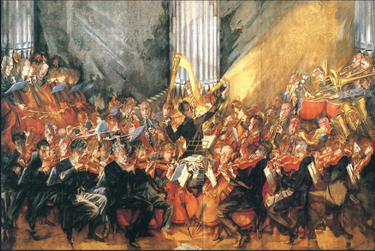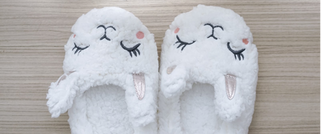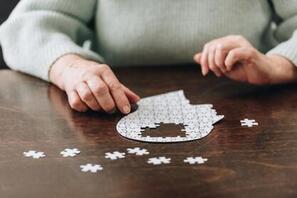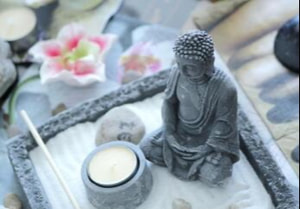 By Pamela Mueggenberg, MA, LMHP I have been deep diving into neurobiology podcasts lately. Listening to neuroscientists, neurologists, and neuropsychiatrists talking about the squishy stuff between our ears has been a fascinating distraction from more concrete endeavors (should I tackle insurance billing or have scientists explain glial cells to me? Hmmm!). I am also learning more about just how entangled our brains are, how infinitely complex these systems are, and how little I know about how our beautiful, transcendent machine of a body experiences and navigates the world. You may have heard of Polyvagal Theory, popularized by Bessel Van Der Kolk in his breakout book The Body Keeps the Score. The idea explores our vagus nerve, one of our cranial nerves that begins in the base of the brain and then goes basically everywhere in our body. It traces along our digestive tract, encircles our kidneys and stomach, tells our heart to slow down or speed up, even travels up our neck through our jaw and over our ears. Polyvagal theorists believe that as we navigate the world different bands in our vagus nerve are activated to provide connection, protection, or shutting us down when things get to be too much. If we can exercise or activate the vagus nerve and heal our relationship with it, then perhaps we are better able to heal from trauma, stress, and disconnection. Polyvagal Theory has fundamentally transformed how people think about trauma. Being able to embody security, focus on connection, and regain a sense of safety through the lens of this theory can make my work as a therapist be much more effective. However, clinicians are ethically obligated to follow the science and since the theory has been in practice, research has shown that there is much, much more to the story. Working with the vagus nerve, we have systems upon systems that are providing a fuller picture of how we feel, how we think, and how we believe the world to be. The cannabinoidal system. The serotinergic system. The HPA axis. The gut-brain axis. The vestibular system. The limbic system. All these systems talk to themselves and each other, and all of them can be pushed off-kilter when we have difficult experiences. We can begin the journey of healing through this major pathway of the vagus nerve, but we need to understand how our thoughts, our medication, our diet, our sleep-wake cycles, our hormones and loads of other variables have to be addressed. We can think of ourselves in discrete parts: the brain, the heart, the gut, the soul. To do so would be turning away from the more complicated, messier, and far more interesting idea that we are music. There are so many instruments, contributing their song to create a vast orchestral piece. We cannot focus on, say, just the violins and declare us treated. Rather, we need to find a harmony within them, make sure they’re all in tune, and thus find peace in ourselves. To read our monthly newsletter, click here.
0 Comments
 By Louisa Foster, PsyD, RDT/BCT I have a made it a practice of turning off the news as of late. Yes, I know I have written about this before. I share it here again because it is an ongoing commitment I must make to myself, especially as the political landscape begins to burn its way into our consciousness again. It was a gradual disconnection which began with relying on aural media only, to spare myself the images of suffering, loss, and plain idiocy. Now, I find myself staying informed through friends, trusting that anything that I truly need to know to maintain my status as a world citizen will make its way to me through them. Though I will admit that I now worry about them and their exposure to toxic storytelling and heightened fear-driven rhetoric. There are challenging days ahead. We know this in our bones. Though we may not yet feel the bite of change, we know it is imminent. We are holding a breath that will need to be exhaled when the forces that are brewing conflict and mischief in our world finally clash. We hunger for ways to make sense of this chaotic world, as we teeter on the edge of the unknown abyss, where the world before us is shrouded in dark gauze. Imperceptible, frightening even, as the unknown always is. What will the coming months bring as we navigate the treacherous roads of political division, cultural strain, climate change, willful ignorance, and uninformed self-righteousness? There is a palpable sense that monsters lurk around every corner, and we find ourselves ill-prepared to face them. But there have been monsters before. These monsters that call out in each of us our highest capacity as monster hunters and bringers of the light. And there will be monsters again, as the wheel of human experience continues to turn ever forward. Our forefathers and foremothers had better tools to handle these liminal spaces. Before the advent of science and mathematics to explain our world, our ancestors relied on myth, story, and oral tradition to explain not only the sacred, but the mundane as well. Once the age of reason began to supplant our communal storytelling practices and dismiss any pursuits of knowledge that could not be empirically validated, we left the path of image-based learning and healing in favor of the quantifiable and concrete. Yet both are needed to navigate the challenges of our world. We must be able to understand at profound levels both our tangible reality and our inspired dreams of who we can be, as individuals, as community, as a nation, and as a planet. Here, at this time in history, we find ourselves on the precipice of what is both sacred and what is profane - two archetypes that often travel together in unremitting and uncomfortable tension. However, from these moments, if we can stay present and alive in this discomfort, if we can hold the tension of these opposites, a glorious third option may emerge. In honoring all those who have come before, in the millennia that have encompassed all human experience, all those who have weathered discomfort, political corruption, a commitment to greed rather than compassion, we know that we can survive this threshold space. We might ask “What new, or rather, what old tools can we bring to these experiences?”. Surely the answer does not lie in the news, in reality television, or in the circles of despair that we gather in to bemoan the state of the world. Perhaps it is time to look towards old stories for the answers? Perhaps it is time to let go of the idea that logic and rationality, in the absence of expansiveness and mystery, are enough to bring us through? Both are needed now. Only both the collected logic of rational thought, as well as the aspirational reverie and poetry of the human experience can help us cross this threshold. In the coming months, I invite you to join me on an exploration of both modern and ancient stories, old and new traditions, and art making in service of facing the monsters, both internal and external. This series of workshops use an art form known as Mythopoesis, the writing of our own personal myth, to be used as a lantern to illuminate our path as we move forward through the dark. Let us together banish those forces that keep us from experiencing our own power. This is an opportunity to shed a skin that no longer fits, to experience ourselves and the world through the eyes of old wisdom and, together, to find the third option. In these workshops, we will steward the old stories and rebirth them in our modern understanding. We will rewrite our own stories and join together, not to feed our grief, but to honor it, and to experience ourselves in a community dedicated to seeking our own wisdom for the betterment of all. *Our first Mythopoesis workshop will take place at the end of October (see above). Stay tuned for more information.  By Kara Cavel, LICSW, Ph.D. If you have read my contributions to the CML Newsletter in the past, you know how I love to use the practice of Tarot to ground and center me. In keeping with this newly established tradition of writing about this practice, I would like to offer a meditation on “The Lovers.” I chose this card because it is the 6th card in the Smith-Rider Waite Tarot deck, one of the 22 cards known as the Major Arcana, and June is the 6th month of the year. The card is full of imagery, but to summarize, we see two people standing in a garden, the Tree of Life behind the male figure, the Tree of Knowledge behind the female figure, and an angel overlooking both. The number six represents harmony, cooperation, and reciprocity. The two states of reason (head) and passion (heart) are invited to emerge and join as one, helping us consider how to reach a divine and awakened spark within. This spark is difficult to achieve in isolation, and “The Lovers” card suggests that love of others, as a spiritual practice, helps us transcend life’s separation from each other and all beings, returning to the mystical ideal of wholeness. The angel hovers to remind us that we are not alone and that if we look closely and with intention, we can discover connections with all beings despite our differences. Recently, my partner and I helped one of our senior pets cross the rainbow bridge. This was a difficult decision, but we made it our last act of love to help our beloved animal leave his physical body in peace, surrounded by care and calm. A few days later, a small bird with hints of green feathers flew into our sliding glass door. My heart, tender from our recent loss, cried for the bird as we moved her to safety. We brought a bottle cap full of water and sat with the bird for a while. To my surprise, the bird recovered and flew away. Relief and joy filled my heart, and the connection I felt for the beings of our world was strengthened. “The Lovers” card reminds to make the decision to love, to ask what I can learn about love from others, and to learn the lessons from others that I may not really want to learn (like how to let go). In both the love I had for our beloved pet, and the concern I had for the temporarily injured bird, I was invited to understand the lesson of letting go and embracing the difficult cycle of birth, death, and re-birth. During the season of summer, it seems like growth and love are abundant. People are tending to their gardens, flowers, chickens, and walking outdoors more with their furry friends. Everywhere I look, I see the magic of how tending to something with love facilitates growth. And as the summer fades and we transition into yet another season, we will find that there is love in the process of letting go, as we see all that we have tended to slowly move into the dormancy of the winter months. Let the most abundant season of our year, teach us the importance of how love transforms.  By Daniel G. Weidner It was 2015 when a wealthy real estate playboy came down his golden escalator to announce that he was running for President of the United States. His speech was so outlandish, vulgar, and banal that many observers figured that he did not stand a chance to win election to the nation’s highest and most powerful office. But it got much worse moving forward from there… He effectively opened up a sewer of disrespectful, bigoted, condescending, mendacious, and harmful speech. This was the beginning of the end for the norms of political speech in our country -- which were not that great to begin with. This breakdown in ethical and respectful speech was amplified through postings on social media as well as through propaganda inserted into social media from foreign nations and some “news” outlets. A toxic fermentation of this kind of speech became the new normal in our political dialogue. It continues to this day. As a practitioner of Mindfulness and as a person who is attempting to integrate the Noble Eightfold Path into my life, I have struggled with this unwholesome and disrespectful type of speech. I have found myself expressing my anger and concern about the current political situation (in person, in text messages, and on social media) in ways that clearly do not follow the ethical blueprint put forth in the Noble Eightfold Path – specifically Right Speech. Right Speech is described as abstaining “…(1) from telling lies, (2) from backbiting and slander and talk that may bring about hatred, enmity, disunity, and disharmony among individuals or groups of people, (3) from harsh, rude, impolite, malicious, and abusive language, and (4) from idle, useless, and foolish babble and gossip. When one abstains from these forms of wrong and harmful speech one naturally has to speak the truth, has to use words that are friendly and benevolent, pleasant and gentle, meaningful, and useful. One should not speak carelessly: speech should be at the right time and place. If one cannot say something useful, one should keep “noble silence.” (As described by Walpola Sri Rahula in the journal Tricycle: The Buddhist Review). This is clearly a high bar to negotiate in our current culture of discourteous, brash and often audacious speech. Speech is herein defined as any form of communication with another. Engaging in Right Speech involves the inclusion (and practice) of the other components of the Noble Eightfold Path. Right View, Right Thinking, and Right Mindfulness being the most salient for the practice of Right Speech. It is within these components of the Noble Eightfold Path that one finds the attributes of compassion, empathy, understanding, acceptance, and non-judgement. These five components might also be considered as essential for “wokeness”. Finally, Right Speech must include speaking (or other forms of communication) the truth. Truth is sometimes cited as justification for speech that would not be considered as Right Speech. Thich Nhat Hahn says: “It may be the truth, but if our way of speaking causes unnecessary suffering, it is not Right Speech. The truth must be presented in ways that others can accept.” In other words, truth is not a justification for the use of mean spirited, toxic, or harmful speech. Thich Nhat Hahn includes filmmakers, musicians, artists, and writers in his description of Right Speech -- if we intend to move again in the direction of peace, joy, and faith in the future. Thich Nhat Hahn (TNH) considers deep listening as foundational for the practice of Right Speech. He says that if we cannot listen mindfully, we cannot practice Right Speech. He goes on to say that “…if you really love someone, train yourself to be a listener.” We do this because this is the best way to show someone that you love them. The Bodhisattva Kwan Yin is the one who hears (deeply listens to) the cries of the world. She has the quality of listening deeply without judging or reacting. Therapists and counselors who practice Mindfulness endeavor to suffuse this philosophy into their professional practice. TNH goes on to say that: “Our anger, anxiety, and fear are the ropes that bind us to suffering. If we want to be liberated from them, we need to observe their nature, which is ignorance, the lack of clear understanding.” It is, in fact, ignorance that I believe is at the root of much of the trouble in our nation today. It is a lack of clear understanding, combined with fear and resentment, which lie at the base of the divisiveness and harmful speech that we see so prevalent in parts of our political and social milieu. I sincerely believe that Mindfulness is a practice that can help to lift us out of this quagmire of ignorance, fear, and resentment. So, where do we go from here? Every path of change begins with recognition. Recognition of the way that things are. Specifically, recognition of our own role and behavior in relation to all forms of “speech”. Once recognition is attained, we then must move to acceptance of the way that things are. Acceptance does not mean liking or disliking the way that things are -- that is judgement. It means accepting things as they are in the present moment. We must recognize and accept the reality of the way that things are as we experience it. Once we have attained recognition and acceptance we then find ourselves with choice. The choice that we have is to do something that will be a part of the solution, or to (at least) discontinue any behaviors that can lead to the ongoing dysfunction in our culture and society. This choice then offers an opportunity to initiate a mindfulness practice that will lead to a better understanding of the way that things are. There are three basic questions, that when asked of ourselves can lead us to recognition of our speech as right speech or unacceptable speech. Before we speak, or write, or otherwise communicate, we can ask ourselves: Is this true? Is this necessary? Is this kind? This mindfulness practice does not require a great deal of time to effectuate. It does, however, require (1) recognition of the impact upon us of what we are hearing (reading, seeing) in the current moment, (2) consciousness of our response options, and (3) understanding of the resultant impact of whatever action that we might choose when initiating a response. When there is injustice, condemnation, blame, anger, or resentment involved in a specific event (or perception) this task can become more complicated. When we find ourselves in a situation that generates emotional reactivity it can be somewhat more challenging to not react in an impulsive and unacceptable manner. This, again, is where recognition must be where we begin. It is essential that we first recognize our own feelings, history, and past responses to similar situations that generate emotional reactivity within us. We must also recognize our own emotional reactivity as it is happening, in the present moment. Recognition in this regard then offers us the opportunity to choose Right Speech. All human endeavors (i.e., art, music, cooking, engineering, science, etc.) begin in the human imagination. Therefore, we must first be able to imagine a better, more considerate, and peaceful world. That conceptual recognition can then lead us to practices that will result in a better world. Right Speech is something that each of us can contribute, on a daily basis, to the creation of a more just and peaceful world.  By Laura Crosby Like many who spent the last few years doing virtually everything virtually, I became accustomed to living in lounge pants and slippers. Even now, my wardrobe, not to mention my fashion sense, is stunted — as is my ability to care about such things. Feeling entirely justified blaming my disheveled state on the global pandemic, I was only mildly bothered recently when I realized I was wearing my slippers — bedroom, not ballet — out to dinner with a good friend. Sporting slippers in public is a thing, but I think it only counts when you do it on purpose, with intention and self-awareness. So to be clear, I was not doing the thing. Pretty quickly I gave myself a free pass on the glaring question of how someone so dedicated to mindfulness could be that oblivious to something so obvious. (phone calls, keys, texts, dogs, news … all the things.) While that could have been the end of the story, the experience stayed with me, with my slippers whispering musings that made me smile for weeks after. Here are a handful just for fun. Laughter IS great medicine! Everything is not always as it seems. It’s amazing how much like shoes slippers can feel – how like truth misperception can seem. When first spying slippers on my out-to-dinner feet, my mind refused to believe it. It just did not compute. It was a reminder that feeling true and being true are not always the same thing. If I’m taking myself more seriously or life more personally than I would if I were in my slippers, I might want to relax and let go a little. It’s hard to feel like a big deal in fuzzies so this was a fun chance to check in and recalibrate. I can be willing to be more vulnerable with safe friends. Real friends welcome my harmless slip-ups. The dear one sitting across from me in my silly slippers made it very safe for me to be flawed and vulnerable without any of it being a problem. A gift! I can practice “choosing to make the unwanted wanted.”* Isn’t it odd how something as pleasant as slippers can be wanted one moment and intensely unwanted the next? “Stuck” as I was in my unwanted slipperedness, I began surrendering, which allowed for a relaxed shift from resisting to letting be to welcoming. A good warm-up for more difficult times. The world still needs “Free to be you and me.”* Liberating my slippers, albeit inadvertently, got me reflecting on liberties, freedoms, civil rights, and privileges – those enjoyed as well as those denied or threatened. A student of history, I notice that what once seemed radical – like women venturing beyond slippers, hearth, and home to vote, work, and lead – is now considered the norm by most. I hope and work for a time when the liberties we fear are too radical today find a peaceful way of becoming our norm. A norm of greater understanding, compassion, equity, and peace where we are all free to be you and me. My slippers now sit by the door. *From Jane Hirshfield’s poem “A Cedary Fragrance.” **An album and song by Marlo Thomas and Alan Alda, popular in the 1970s.  by Marilyn Erickson, MSN, APRN At certain times in our lives, we question our thinking, our memory, our abilities to carry out certain skills, and even our sense of self. Throughout our lives we experience things that create patterns of activity that explain how our brains code these aspects. Our brain is really a universe of activity. It works for us 24 hours a day, 7 days a week. It creates thoughts, drives our emotions, and stores our memories. It is so busy that when we think, see, or move, electrical signals race among billions of nerve cells. It is amazing! It is resilient! It is powerful! And our brain gets better with use! Our brain health is essential for our quality of life and longevity. So, are there things we can do to preserve our brain health? Research supports that we absolutely can make a difference with our lifestyle choices. What we eat and drink, how much we exercise, how well we sleep, the way we socialize, and how we manage our stress are critical to maintain our brain health. Physical Exercise: Get moving! When we exercise regularly, we have a lower risk of developing Alzheimer’s disease. Exercise improves blood flow and memory. It stimulates chemical changes in the brain that enhance our learning, mood and thinking. Regular aerobic exercise, like running, biking, and swimming preserve existing brain cells, and foster the growth of new ones. Research shows a link between long term, moderate physical activity, and an increase in volume of the hippocampus, the area of the brain that deals with the formation of long-term memories. This area is the first to be damaged in Alzheimer's disease. Food and Nutrition: We really are what we eat! There is a process called oxidation that damages brain cells. Oxidation occurs with exposure to harmful stress that is due to our lifestyle and environmental factors. Foods rich in antioxidants aid our body’s defense from the harmful effects of oxidation to our brains. The Mediterranean-style diet is rich in fish, whole grains, green leafy vegetables, olives, and nuts. Research shows that it can help maintain brain health and may reduce the risk of Alzheimer’s disease. In contrast, diets rich in saturated, fat, sugar, and processed food can impair brain health. In addition to a healthy diet, some supplements and specific nutrient intake can also be important for our brain health. Some examples are:
If you want to use the combination caffeine and theanine, take 200 mg of both caffeine and theanine (400 mg total) about 30 minutes before you need increased focus and concentration. In most cases, the effects of caffeine and theanine are most potent in the first 2 hours after ingestion. In healthy adults, caffeine intakes up to 400 mg/day don’t raise any general health concerns. However, it should be cycled based on its stimulatory effects. If it no longer provides noticeable benefits, supplementation should be stopped for 2-4 weeks to reset tolerance. Sleep and Relaxation: Rest well! Sleep really does energize us. It improves our mood and immune system and may reduce buildup in the brain of an abnormal protein called beta-amyloid plaque, associated with Alzheimer’s disease. In addition to quality sleep, practicing meditation and stress management techniques can be helpful for brain health. According to the CDC, age is a factor in the amount of sleep needed: For 13-18 years of age: 8-10 hours are needed. For 19-64 years of age: 7-9 hours are needed. For 65 years and above: 7-8 hours are needed. Mental Fitness: Use it or lose it! Mental exercise is just as critical as physical exercise and keeping your brain fit and healthy. Mental exercises may improve your brain functioning and promote new brain cell growth. You can memorize. When we work our brains through memorization we are stimulating neural plasticity, which alters the brains’ nerve pathways in response to new experiences. These functional brain changes appear to be important in warding off cognitive decline. We can also find something new to learn, like a new hobby or skill. Social Interaction: Stay connected! Spending time with others, engaging in stimulating conversation, and staying in touch and connected with family and friends are good for our brain health. Studies have shown that those of us who have the most social interaction in our community experience show the slowest rate of memory decline. Not only will these 4 areas of self-care help in our brain health, they are just so helpful in giving us a good quality of life today. I will leave you with some further research and investigations going on related to brain health: Dopamine and serotonin are neurotransmitters. They are frequently associated with the brain. Yet, more than 90% of serotonin and 50% of dopamine are found in the gut. More to come in the area of the brain-gut connection! We can start today to improve our brain health. It is never too late to start! References: Cleveland Clinic, Healthy Brains.org Examine.com Brain Health (large database of supplement and nutrition research) cdc.gov/sleep  By Pamela Mueggenberg, MA, LMHP, LPC Every few years, popular scientific journals like to write about the “hypersane,” the enlightened breed of individual who has experienced trauma or great suffering, and rather than breakdown they “break through” and become the best versions of themselves and, possibly, anyone else. Carl Jung was termed hypersane after his time as a doctor during World War I, when he broke off his friendship with Freud and began his deeper exploration of the unconscious. Diogenes the Cynic is another such nominee; in an article on hypersanity Neel Burton tells the story of Diogenes strolling through Athens in broad daylight, holding a lit lamp. When asked why he would reply “’I am just looking for a human being’ – thereby insinuating that the people of Athens were not living up to, or even much aware of, their full human potential.” There are absolutely people in this world who have transcended their psychological suffering and arrived at greater clarity, groundedness, and peace. There are also many, many people who are faced with similar trauma (more than 70 million people fought in World War I, with more than 40 million military and civilian casualties) who did not arrive at such peace. Trauma is not a test, and definitely not a gift. Trauma is injury of our mind, body, and spirit when faced with the chaos and violence that exists in the world. We have no right to judge when or how others heal, nor can we rank each other’s ability to move through pain. What if, instead, we assume we are all sane? That we all have worth, even those of us who are still struggling with the weight of our wounds? What if we all commit to helping each other reach a level of peace, hand in hand, unburdened by the (frankly patriarchal) assumption that we need to individually master our own trauma? Celebrated author and educator Lidia Yuknavitch writes in her book The Misfit’s Manifesto, “Death, grief, trauma are alive in our actual bodies. We carry them our whole lives, even if we act like it’s possible to “step out of them.” Writing, making stories, drawing and painting, and making art doesn’t release me from loss or grief or trauma, but it does let me re-story my self and my body. In this sense, to be a misfit means to be willing to dive into the waters of one’s life, swim to the wreckage at the bottom, and bring something back to the surface…. If you are one of those people who has the ability to make it down to the bottom of the ocean, the ability to swim the dark waters without fear, the astonishing ability to move through life’s worst crucibles and not die, then you also have the ability to bring something back to the surface that helps others in a way that they cannot achieve themselves.” Yuknavitch’s misfits are flawed. She herself describes her own actions as she figured out how to live in a body that was assaulted by loss and pain as “unethical,” “hungry” and “dangerous.” These actions show how deeply you have been injured, and do not exclude you from being worthy of compassion. To put it more directly: you, the person reading this article, yes you, are worthy of compassion. You are not your trauma, and you are also not “doing trauma wrong” if you have made decisions that don’t fit with who you are. You will find your way, and if you ever get lost, there are so many people in this world who can – and want to - help. Misfits are everywhere. References: On Hypersanity: The hypersane are among us, if only we are prepared to look. Neel Burton M.D. Posted in Psychology Today, August 12, 2019. The Misfit’s Manifesto, Lidia Yuknavitch. Copyright 2017, TED Books/Simon & Shuster.  By Marilyn Erickson, APRN (This is Part III of a three-part series on Sleep. If you missed Part I, you can read it here and if you missed Part II, you can read it here.) The supplements that are presented here are to be used or tried in addition to the strategies presented in part 2 of this series. These herbs and nutrients can nourish your nervous system, restore balance in your autonomic nervous system, support neurotransmitter production and give you extra help in relieving anxiety and depression and generally help in improving your mood. However, don’t forget other strategies that can help you get a good night’s sleep including:
Along with all of the above, the following are supplements that provide natural support for sleep (and for mood): L-theanine: a calming amino acid found in green tea. It can increase alpha brain waves and thus help with relaxation as well as focus and alertness. Research supports that it promotes mental health when stress is a factor. It enhances the production of neurotransmitters (e.g. serotonin, dopamine and GABA). Recommended dose is 100-200 mg per day. Lavender: used for its essential oil or aromatherapy. It can deepen sleep, reduce anxiety and relieve tension. Some evidence suggests that lavender can increase slow-wave sleep patterns. It can assist with less waking during the night. If the essential oil is your preferred method, the dose is 60 mg capsule before bedtime. It is, however, not recommended if you have personally had estrogen-receptor-positive cancer. Aromatherapy use is acceptable in pregnancy. Magnesium: is an essential dietary mineral. It promotes relaxation and relieves anxiety and depression. Magnesium glycinate, citrate and lactate are best for supplementation and the dose recommendation is 400 to 600 mg per day. Melatonin: is a neurohormone secreted by the pineal gland in the brain. The primary use for melatonin as a sleep supplement is to normalize abnormal sleep patterns. Light suppresses melatonin synthesis. It is especially useful for shift work and jet lag. For regulating sleep cycles, 0.5 to 5 mg works the best. Taking higher doses will not bring on sleep faster. Take melatonin about 30 minutes before bedtime. Glycine: an amino acid with many important functions in the body. It can promote sleep quality and also benefit cognitive functioning. The recommended dose is 3-5 gm taken before bedtime. Vitamin B6: Can be taken before bed to relieve night waking by reducing nocturnal cortisol spikes. Studies have also suggested that it can help in the recall of dreams. The recommended dose is 50-100 mg. References: Aspy et al (2018) Effects of Vitamin B6 (Pyridoxine) and a B Complex Preparation on Dreaming and Sleep. Examine Database Hidese et al. (2019) Effects of L-Theanine Administration on Stress-Related Symptoms and Cognitive Functions in Health Adults. Romm, A. (2017). The Adrenal Thyroid Revolution.  By the CML Provider Community At the outset of each new year, the providers at CML offer a word that they will use to guide them in the coming year. It has become a bit of a tradition to be witnessed in this way by our larger community. We make a public affirmation that reflects our intent to grow more fully into who we are becoming. We invite you to do the same. If you feel so inspired, please go to the post on our community Facebook page and share a word, or some thoughts of your own about the upcoming year and how you hope to shape your growth. We look forward to witnessing you in your transformation. “Spaciousness” – Hillary This word has been calling my name for a while. I need it. I need to feel vastness. I want to look out across the open sky and know that there are endless known and unknown possibilities—scary, exciting, beautiful, mundane. I want to feel both small and insignificant, and also more powerful than I’ve ever felt before. I need there to be room for all of it. I want to experience the expansiveness of time, without ignoring how quickly it passes. I want to be curious about all the paths that can be taken, while also recognizing that it’s ok if I’m not doing everything, all at once, right now. There is space for me. There is time for me. I give myself permission to dance in this messy wonder and feel the shifting winds. “Feel” – Jenna The word I am keeping in my focus as I head into 2023 is Feel. I want to Feel more and think less in 2023. I want to feel more joy, pleasure, and peace. I want to feel connected to the people in my life who I love and cherish. I want to feel more at home in my body and less trapped by the thoughts in my head. I want to feel alive and connected to my inner knowing. I want to Feel all the things in 2023. “Rebirth” – Kara My word for the year is rebirth. This word was inspired by a practice I engage in every year with my tarot cards. I add my month and day of birth together for one sum. Then separately, add the digits of the upcoming year….2023. My tarot card for the year is Judgement. Judgement, at first read, sounds harsh, but this card is an invitation to be inspired, awakened, or reborn. This year I am called to let my inner stirrings guide me toward something new. “Intimacy” – Laura I have found an exhilarating wonder and freedom in moments of intimacy with the “suchness” of life. Interestingly, this is as true in profoundly unpleasant moments as in the precious pleasant ones. This intimacy is natural – completely uncontrived – and deeply connecting yet purely impersonal. Sometimes it emerges spontaneously. More often, it arises when my attention, mind, and heart are relaxed and receptive – mindful. The gifted teacher and inspiration Frank Ostaseski writes of this kind of intimacy as “undefended openness” in which we “fully embrace and lovely engage” in life as we “come closer and stay close.” To intimacy with life in 2023 and beyond! “Becoming” - Louisa Entelechy, a term coined by Aristotle, refers to the capacity to realize or bring into existence something that is merely potential. For instance, the acorn’s entelechy is to become an oak tree. I think of it as the “Blueprint of Becoming”, the means of turning thoughts and ideas into reality by getting out of our own way to become who we are meant to be and do what we are here to do. This year, I would like to honor the deep interlacing of both becoming more fully myself as I work to support others in their becoming. There is something about the co-existence of the complexity and the simplicity, the mystery and the practicality, of this that I find compelling. “Nature” - Marilyn The Oxford dictionary defines nature as the phenomena of the physical world collectively, including plants, animals, the landscape and other features, and products of the earth. My intent in writing on nature is not to explore the definition, but more importantly to me, to explore the importance of nature to our well-being and how we can experience the benefits of nature. Being IN nature surrounded by “the phenomena of the physical world” is essential to so many aspects of our well-being. Nature can be calming, creativity boosting, and mind-expanding. M. Amos Clifford, founder and Director of the Association of Nature and Forest Therapy guides and programs in Santa Rosa, California, states that being out in nature is necessary to the very essence of who we are. Clifford runs "forest therapy" programs which are rooted in what the Japanese call, Shinmin-yoku, or forest bathing. The forest bathing, or the idea that going for a walk in the forest, without smart phones, and other digital devices is a form of preventive and even healing medicine. According to Ayurvedic principles, being out of alignment with nature can lead to illness and unhappiness, and science is just starting to confirm this idea. Spending less time in nature and more time indoors is resulting in our natural biorhythms being out of balance and harmony. So take a step into nature and notice: Do you see the green plants or do you see the spaces between them? Getting closer, really close, and get down on the ground and take a look. What are the colors you see? How many shades of green? Breathe in the scents and listen. And also look up! Or you can choose to take in the bigger picture, the landscape, and notice the colors, smells, and sounds. It requires you to be present. In a deeper sense nature can fill us with a sense of gratitude, but also a sense of responsibility and reciprocity. Robin Wall Kimmerer states the following in Braiding Sweetgrass, “We are showered every day with gifts, but they are not meant for us to keep. Their life is in their movement, the inhale and the exhale of our shared breath. Our work and our joy is to pass along the gift and to trust that what we put into the universe will always come back”. Experiencing nature as well as ensuring nature is there for others who follow us, is part of the bounty that is gained for us when we recognize nature’s importance to our physical, mental, emotional, and spiritual well-being. “Light” – Pamela My word for 2023 is LIGHT. The illuminating light of understanding, the light of life and connection, and also to lighten our collective weight as we continue to heal from the past several tumultuous years. To live is to sometimes get hurt, but as Rumi said, “the wound is the place where the light enters you”. I hope for all of us to let the light in.  By Daniel Weidner The Buddha, the Dharma, and the Sangha are the three foundational legs of the Buddhist tripod. The Buddha was the original teacher, the Dharma consists of the teachings of the Buddha (and his followers), and the Sangha is the spiritual community that connects those who study and practice the Dharma -- as taught by the Buddha and his followers over the last 2,500 years. These are often referred to as “the three jewels” of Buddhist Mindfulness practice. I began to study the Dharma in the early seventies. Americans at that time who wanted to learn the Dharma had to travel to India, Tibet, Thailand, and other countries in the East if they wanted to participate in any in-depth teachings and practices emanating from the Dharma. Sanghas were few and far between in the United States. At that time there was no internet and there were very few books or journals (published in English) available for learning the Dharma. However, it was at this time that the teachings of the Buddha were increasingly beginning to appear in western culture, and the Dharma began to become sporadically available. Sanghas, or communities of mindfulness practitioners, were slowly beginning to develop in the West. These communities first began to appear in California, Colorado, Oregon, and some places on the East Coast. Individuals who were living in other parts of the country, including the Midwest, (e.g., Omaha) had to travel long distances to connect with others who were learning and practicing Mindfulness. As a young college student, living in Omaha in the early seventies, I felt somewhat alone as a student of Mindfulness, and there were no sanghas where I could join with, and learn from others. The Sangha is not considered to be an optional part of the practice of Mindfulness. It is understood to be essential to learning and practicing the life lessons that were taught by the Buddha. The teachings of Mindfulness can sometimes feel esoteric and somewhat abstract or difficult to translate for those living in Western culture. The Sangha is where students of the Dharma can come together to learn about and share in the teachings, and to develop the practices that facilitate one’s ability to live in a mindful and conscious manner. It is the place where the teachings can become less abstract and become functionally operational. The Buddha taught that good friendship, good companionship, and good comradeship are essential to one’s ability to learn and assimilate the teachings of Mindfulness into one’s life. The Buddha taught that the Sangha is the path - that spiritual friendship is the path. Sanghas can take many forms and are subject to the variations and vicissitudes of most human endeavors. The sangha has sometimes been referred to as a quilt that is woven together through the teachings of the Buddha and the spiritual friendships that develop among the members of the Sangha. But the Sangha is not just a “club” or social vehicle. It is a place where students who want to develop their understanding and practice of Mindfulness can come together to learn and practice as a community. It is a place where practitioners can meditate together, study together, and engage the teachings of mindfulness (Dharma) with like-minded individuals. The Buddha stated that “To avoid foolish persons and to live in the company of wise people…, this is the greatest happiness.” The Sangha makes this possible; the Sangha is where this all comes together. My first “sangha” consisted of a small group of persons who came together to practice meditation in the basement of a woman who lived in midtown Omaha. This meditation group was informally organized by a woman named Patti, who has now become one of my most cherished friends and my Dharma-Sister. It was in this informal group, which met twice per month, where I first began to feel less alone in my mindfulness practice, and where I began to be able to explore and expand upon the teachings of the Dharma. This is where I began to truly understand the immense value of participation in a mindfulness focused spiritual community – however small it may have been at the time. Today in Omaha, we are very fortunate to have a variety of spiritual communities available for those who wish to learn and grow in the practices of Mindfulness. Patti introduced me to Dr. Louisa Foster. Louisa had formed a nascent sangha that she called The Center for Mindful Living (CML). CML brought together practitioners of mindfulness and Mental Health Professionals who utilized the teachings of mindfulness in their practices. Initially it was a fledgling community that was just forming an identity and purpose. Louisa had a vision for CML and she worked tirelessly to see it come to fruition. She sought out likeminded individuals to help her to develop and grow the CML. There were therapists and others whom she gathered to facilitate the realization of her vision. This midtown sangha slowly began to grow and prosper. Patti and I both taught Mindful Meditation at CML. Today CML is one of several sanghas that can be found in the Omaha metropolitan area. I consider it to be my Sangha. It is a place where beginners as well as experienced practitioners can come together to study and practice the Dharma of Mindfulness in an open, accepting, caring, and mindful environment. I no longer feel alone in my mindfulness practice. I am forever grateful to be a part of this now thriving spiritual community. Namaste |
Archives
July 2024
|

